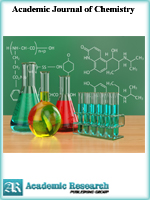Academic Journal of Chemistry
Online ISSN: 2519-7045
Print ISSN: 2521-0211
Print ISSN: 2521-0211
Quarterly Published (4 Issues Per Year)

Archives
Volume 4 Number 10 October 2019
Synthesis and Antifungal Study of Some Acetophenone Oximes and Their Terphthaloyl Oxime Esters
Authors: Ramadan Ali Bawa ; Mona Mohammed Friwan
Pages: 96-101
DOI: doi.org/10.32861/ajc.510.96.101
Abstract
Acetophenone oximes 1 – 5 along with their terphthaloyl oxime esters 6 – 10 have been synthesized in moderate to good yields. Only one oxime was formed in as E/Z two isomers in a ratio of (8:1). These resulting oxime derivatives were involved in an antifungal screening against the Aspergillus niger at concentration of 30 ppm. Two commercially available antifungal agents, clorotimazole and daktarin, were employed as references at the same concentration, 30 ppm. The antifungal results for the oxime derivatives 1 – 10 showed inhibitory levels ranging from 38% to 100%, whereas the antifungal potentials for the two references were found to be ~ 63% and 68% for clorotimazole and daktarin respectively.
Valorization of Typha Australis Stems in Bioethanol Production Using Enzymatic Hydrolysis and Biofermentation
Authors: Cosme Sagbo Kouwanou ; Cokou Pascal Agbangnan Dossa ; Euloge Sènan Adjou ; Mossi Issiakou ; Valentin Dieudonné Wotto ; Dominique Codjo Koko Sohounhloué
Pages: 90-95
DOI: doi.org/10.32861/ajc.410.90.95
Abstract
The present study aims to valorize the Typha australis stems, through second-generation bioethanol production using enzymatic hydrolysis and fermentation. The monitoring of fermentation kinetics parameters, such as pH, density, length of fermentation, and the Brix, indicated a great variability of these parameters during the fermentation process of the must with three Saccharomyces cerevisiae strains, such as Angel brand Thermal-tolerant alcohol active dry yeast, Angel brand super alcohol active dry yeast and Angel super alcohol active dry yeast in the presence of urea (CON2H4) used as a growth factor. The distillation of musts after fermentation has yielded ethanol extraction rate (% v / v at 20 ° C) between 4.95and 44.93 after fractional distillation. The best performance in ethanolic bioconversion was recorded with Angel brand super alcohol active dry yeast. This Saccharomyces cerevisiae strains could be used as effective ferments, in perspective of intensive production of second-generation bioethanol with Typha australis stems.



